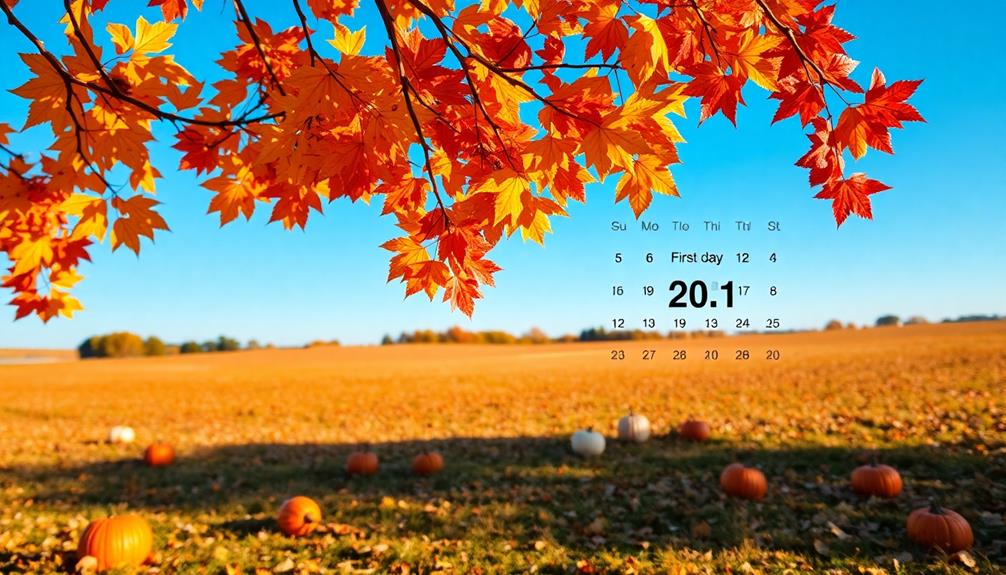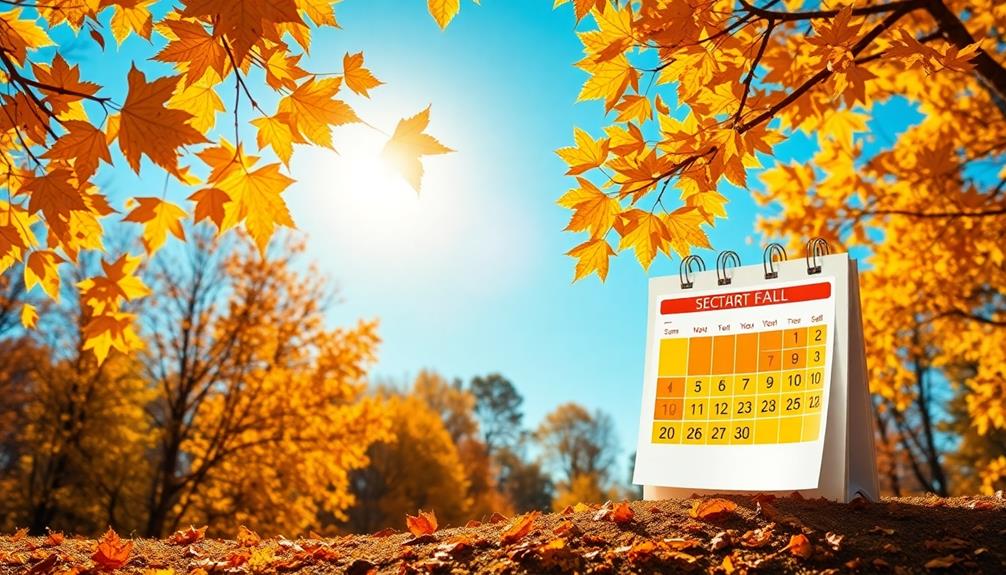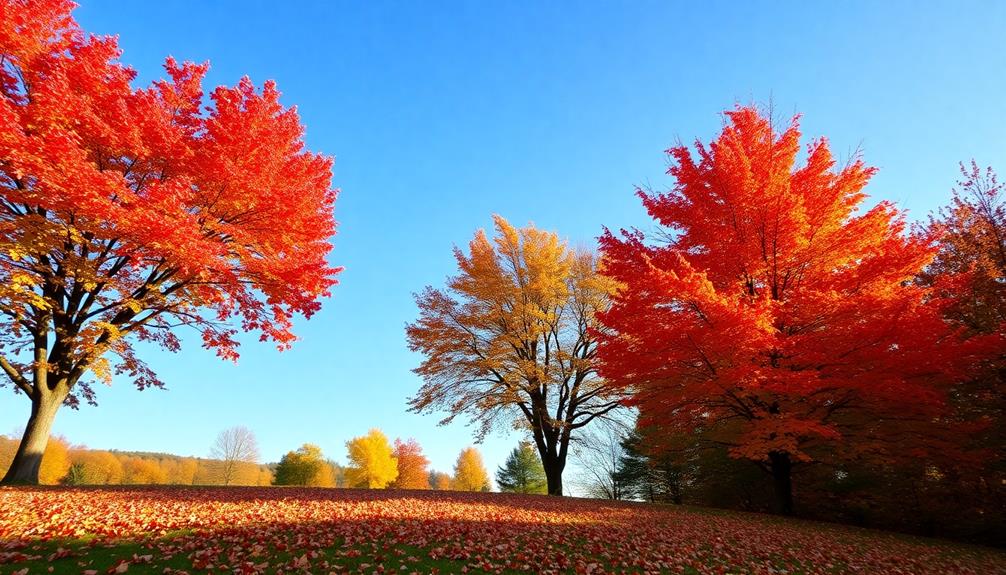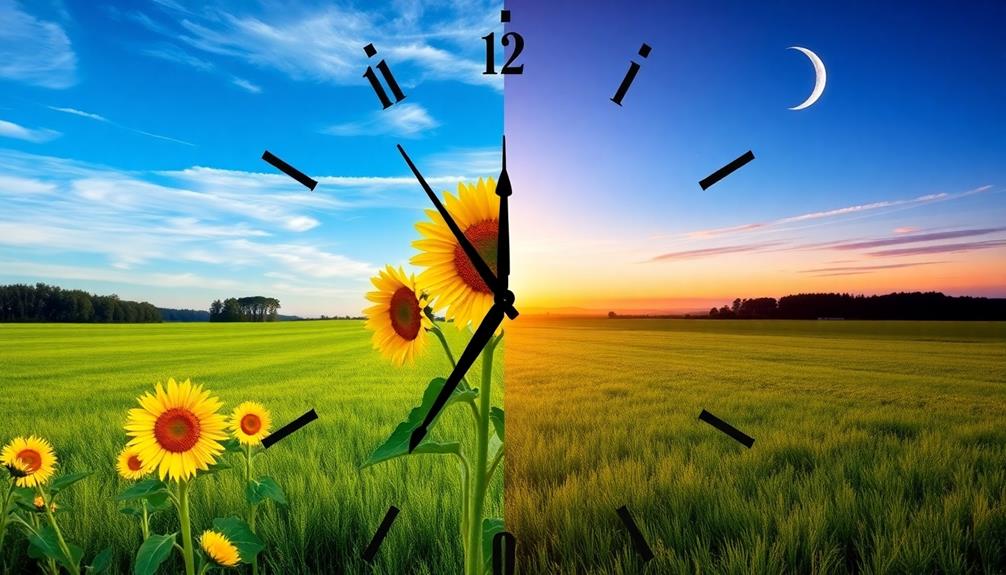Mark your calendar for September 22, 2024, at 8:44 a.m. EDT. This is when fall officially begins with the astronomical autumnal equinox. On this day, both day and night are nearly equal in length, signaling a shift from summer's warmth to the cooler temperatures of autumn. While meteorological fall started on September 1, the equinox marks an important change in climate and nature. You can expect beautiful fall foliage and a series of festivals celebrating the season. Stick around to discover more about what autumn has to offer this year and how it shapes our lives.
Key Takeaways
- The first day of fall 2024 is September 22, at 8:44 a.m. EDT, marking the autumnal equinox.
- Astronomical fall begins on this date, with nearly equal day and night lengths.
- Meteorological fall started on September 1, based on annual temperature cycles.
- Fall is characterized by cooler temperatures and environmental changes leading into winter.
- Key autumn festivals, such as Thanksgiving and Oktoberfest, celebrate the season's spirit and harvest.
First Day of Fall 2024

The first day of fall in 2024 arrives on Sunday, September 22, at 08:44 a.m. EDT in the Northern Hemisphere. This date marks the beginning of astronomical fall, coinciding with the autumnal equinox. On this day, you'll notice that day and night lengths are nearly equal, a beautiful phenomenon observed worldwide.
As you embrace the first day of fall, keep in mind that meteorological fall has already started on September 1. While many people celebrate the shift in seasons on the equinox, the earlier meteorological fall is based on temperature cycles rather than astronomical events.
The autumnal equinox signifies a major change in weather patterns, with shorter days leading us toward the winter solstice on December 21. In 2024, you can expect this change to bring cooler temperatures and a change in the environment around you.
As leaves begin to change colors and fall from trees, the essence of autumn becomes palpable, reminding you that the days ahead will increasingly reflect this beautiful season. So, mark your calendar and get ready to enjoy the unique charm of fall starting September 22, 2024!
Understanding Meteorological Seasons

Understanding meteorological seasons offers a straightforward way to grasp the annual changes in weather and climate. Unlike astronomical seasons, which depend on the Earth's position relative to the sun, meteorological seasons are based on annual temperature cycles. They divide the year into four equal parts: spring starting March 1, summer on June 1, fall beginning September 1, and winter commencing December 1.
Meteorological fall lasts for a three-month period until November 30, characterized by cooler temperatures and changing foliage. By understanding these seasons, you can better interpret climate statistics and engage in effective weather forecasting. Knowing when fall starts helps you prepare for the seasonal shifts, from crisp air to the vibrant colors of autumn leaves.
Additionally, understanding meteorological seasons aids in agricultural planning. Farmers can anticipate weather patterns, allowing them to make informed decisions about planting and harvesting.
As you look forward to the shift from fall to winter, remember that meteorological seasons provide a reliable framework to navigate the yearly cycle of weather changes, ensuring you're always prepared for what's ahead.
The Importance of the Equinox

As the sun crosses the celestial equator, marking the autumnal equinox, you can feel a shift in the air that signals the arrival of fall. Occurring on September 22 at 8:44 a.m. EDT in 2024, this event marks the official start of the fall season in the Northern Hemisphere.
During the equinox, both hemispheres receive nearly equal amounts of sunlight, resulting in approximately 12 hours of daylight and 12 hours of darkness worldwide. This balance, reflected in the term "equinox," which means "equal night," symbolizes the change from the warmth of summer to the cooler months ahead.
The autumnal equinox serves as a pivotal astronomical event that influences weather patterns. As daylight hours gradually decrease, you can expect a shift in temperature and atmospheric conditions, preparing you for the cozy days of autumn.
This change affects not just the environment around you but also the rhythm of life—changing how you dress, what you eat, and even how you feel. Embracing the equinox helps you appreciate the cyclical nature of our world and the beauty that comes with each seasonal change.
Fall Foliage and Weather Changes

Vibrant fall foliage transforms landscapes into a stunning tapestry of colors, enchanting everyone's attention. As autumn approaches, cooler temperatures in October trigger the leaf color change, breaking down chlorophyll and allowing those vibrant colors to shine through.
In North Texas, you'll notice this transformation starting around mid-October, with peak colors peeking in early to mid-November.
Weather patterns play an essential role in how stunning the fall foliage becomes. Cooler temperatures above freezing enhance the deep reds in maple leaves, while warmer weather might lead to a less intense display.
Rainfall and sunlight also greatly impact the timing and intensity of the colors. A rainy season can boost leaf color change, whereas prolonged dryness might dull the palette.
You'll find that regions along the Gulf Coast experience minimal color change compared to other areas due to their unique climate conditions.
Each autumn is a new experience, shaped by these weather factors. So, be sure to embrace nature's beauty as you witness the incredible transformation of the landscape each year.
Traditions and Festivals of Autumn

The beauty of autumn isn't just in the stunning foliage; it's also in the rich tapestry of traditions and festivals that celebrate this vibrant season. As the autumnal equinox approaches, many cultures engage in various celebrations that honor the harvest.
In the United States, Thanksgiving stands out as a major autumn celebration, where families gather on the fourth Thursday in November to share a meal and express gratitude for their blessings.
Across the globe, the Moon Festival in China draws attention with its colorful lanterns and delectable mooncakes, marking the full moon and the bountiful harvest.
Meanwhile, Germany's Oktoberfest, running from late September to early October, showcases hearty food, traditional music, and, of course, plenty of beer.
Don't forget the New England Fall Foliage Festival, where you can immerse yourself in the breathtaking colors of autumn leaves, complete with parades and arts and crafts.
Each of these festivals reflects the spirit of the season, transforming it into a time of joy and connection. So mark your calendars and prepare to embrace the rich traditions that autumn offers!
Transitioning to Winter 2024

Winter 2024 is just around the corner, bringing with it a dramatic change in the weather and landscape. The first day of winter falls on December 21, coinciding with the winter solstice, which marks the shortest day of the year in the Northern Hemisphere. At 4:21 a.m. Eastern Time, you'll feel the shift to winter as the Earth tilts farthest away from the sun.
As temperatures drop, you may notice colder temperatures and the possibility of snowfall in your area. This change from fall to winter greatly alters seasonal weather patterns, often leading to increased precipitation.
You'll see changes in wildlife behavior, too; many animals are busy preparing for the colder months ahead, either by hibernating or gathering food.
After the winter solstice, daylight hours will gradually start to increase, signaling the return of longer days. Embrace this time to enjoy winter activities, from snow sports to cozy evenings by the fire.
The arrival of winter not only transforms the environment but also invites you to participate in the unique experiences that this season brings. Get ready to embrace the beauty of winter!
Frequently Asked Questions
What Marks the Beginning of Fall?
The beginning of fall is marked by the autumnal equinox. You'll notice day and night are nearly equal, with each lasting about 12 hours. This balance highlights nature's shift as temperatures cool.
What Calendar Day Does Fall Start?
Fall starts on the autumnal equinox, which usually falls on September 22 or 23 each year. You'll notice the days and nights become nearly equal in length, signaling the shift from summer to autumn.
What Determines the First Day of Fall?
As you sip your pumpkin spice latte, remember that the first day of fall's determined by the autumnal equinox, with nearly equal day and night, marking nature's stunning shift from summer's warmth to fall's embrace.
Why Is September 22 the First Day of Fall?
September 22's the first day of fall because it's the autumnal equinox, when day and night lengths equalize. This event occurs due to the Earth's position relative to the sun, marking seasonal changes.
Conclusion
As you mark your calendar for the first day of fall, remember that this season isn't just about the date—it's a shift in nature's rhythm. You might notice the leaves turning vibrant shades and the air becoming crisp, signaling a change in the world around you. Embrace the traditions and festivals that celebrate this beautiful transformation. As autumn unfolds, let it remind you of the inevitable approach of winter, inviting you to savor every moment before the cold sets in.










